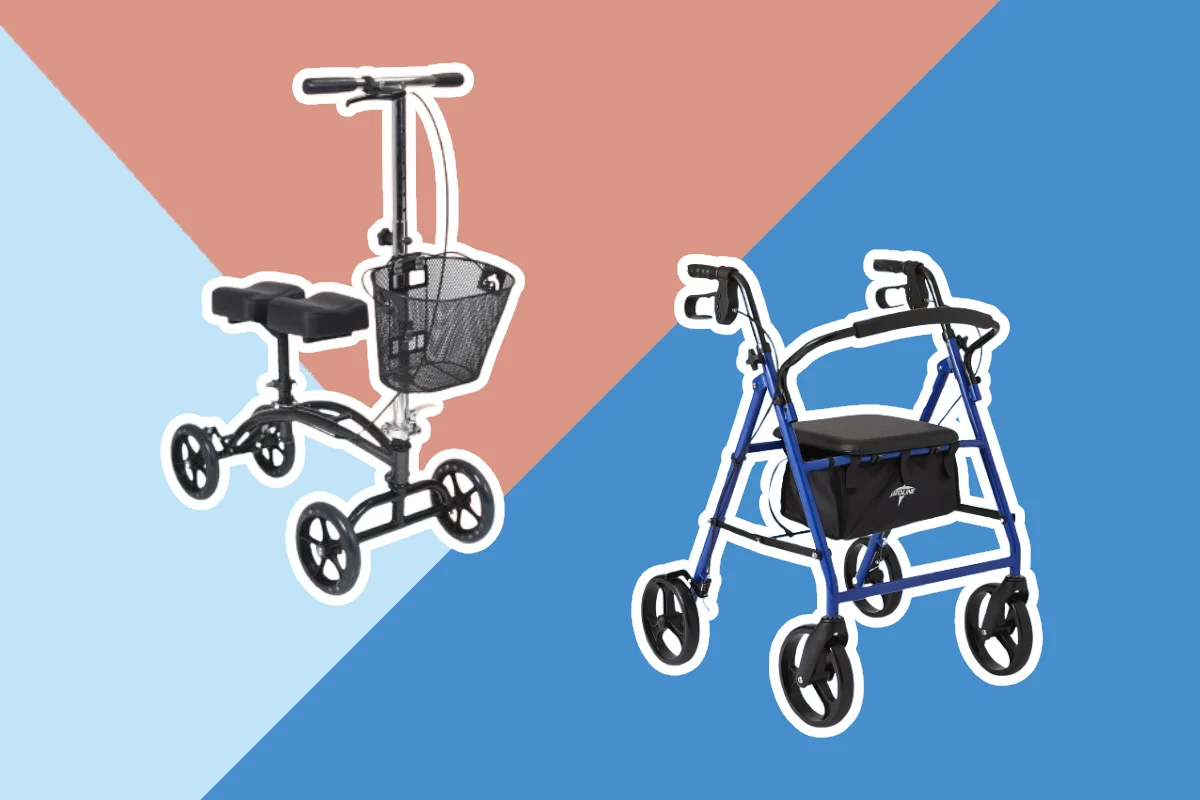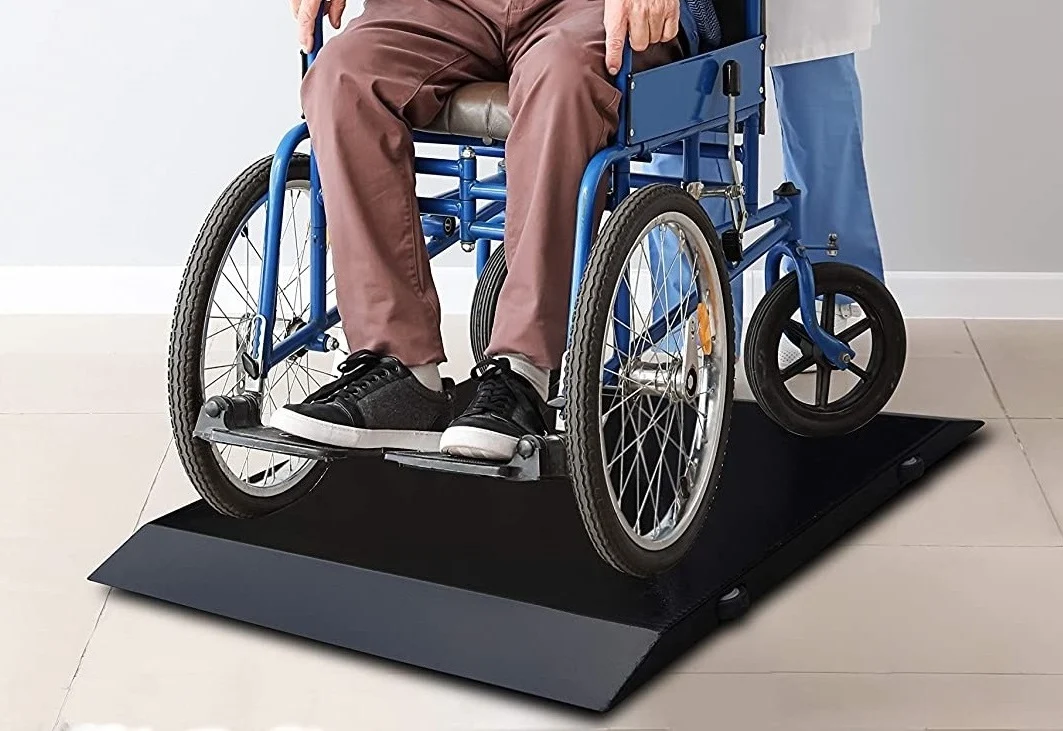Is there any difference between transport chairs vs wheelchairs? Well, they both look alike but they differ in their features and functionalities. For example, wheelchairs are designed for long-term use and they include various options to optimize comfort and independent movement by users. On the other hand, transport chairs are designed for travel. Subsequently, they feature streamlined designs that fit easily in car trunks and narrow spaces. Transport chairs also require the help of another person to push the user from behind the chair. Otherwise, both devices are made to help people with mobility issues to move around, either aided or unaided.
It is estimated that 25% of the adults in the United States use some form of mobility device. We will expound on the differences between a wheelchair and transport chair to help you choose the mobility device that will best serve your individual needs.
What is a Wheelchair?
A wheelchair is a chair with oversized rear wheels with rotating handrails that are designed to help individuals with mobility issues to steer themselves unaided. Wheelchairs are available in various designs, sizes and colors.
Types
There are several types of wheelchairs. They include manual wheelchairs which include foldable and lightweight wheelchairs, all-terrain wheelchairs available in various shapes and styles, pediatric wheelchairs for kids, electric and powered wheelchairs, recliner wheelchairs for ultimate comfort, sports wheelchairs for sports such as rugby, tennis basketball and racing, and wheelchairs for amputees that ease mobility and improve their quality of life.
What is a Transport Chair?
Transport chairs are compact and lightweight chairs that require a second person to push the user from behind. Their small profile allows them easy access through steep and narrow areas.
Types
A transport chair can either be a rollator or a transformer wheelchair with quick release mechanism that easily alternates this hybrid chair between a wheelchair and a transport chair.
Difference Between Wheelchair and Transport Chair
The table below summarizes the differences between wheelchairs vs transport chairs.
| Wheelchair | Transport chair | |
| Control | Self-propelling or with help, features brakes in handles and wheel stoppers | Requires help from another person to move |
| Comfort | Higher weight capacity and ergonomic handles, padded seats and hand/leg rests | Leg rests are elevated, padded handles, not recommended for all-day use |
| Size | Wide choice of narrow and wide models | Narrow chairs that fit in most doorways |
| Wheels | Two smaller front wheels and two bigger rear wheels that can be controlled by hands | Four small wheels |
| Accessories | Trays, carrying bags, cup holders etc. | Limited choice of accessories for the backrest |
| Outdoor use | Wider choice of models fit for all terrains | Better for indoor use |
Wheels
A key difference between wheelchairs and transport chairs is in their wheels, especially the rear wheels. A transport chair has small front and rear wheels that are the same size. A transport chair wheel usually weighs 2 to 3 pounds and has a diameter of 8 to 12 inches. Since the wheels are too small for the user to reach them and the rear wheels do not swivel, a transport chair is designed to be pushed by a caretaker from behind.
Wheelchairs have two small front wheels and two large rear wheels with rotating handrails that allow users to control them by hands to self-propel forward. An average wheelchair wheel weighs approximately 8 pounds and has a diameter of 24 inches. It is made of composite with a rubbery texture. Since a wheelchair is larger than a transport chair, there should be clear minimum floor space of 30×48 inches to ensure a specific area is accessible by wheelchair Trusted Source What would a truly disabled-accessible city look like? Most cities are utterly unfriendly to people with disabilities; but with almost one billion estimated to be urban-dwellers by 2050, a few cities are undergoing a remarkable shift www.theguardian.com .
Although rare, you can find wheelchair models with interchangeable wheels that allow users to convert them into transport chairs. There are also few transport chairs that can be adjusted and transformed into wheeled walkers, or rollators.
 Comfort
Comfort
Comfort is mainly defined by the back support and cushioning of a chair. When it comes to the comfort of a standard wheelchair vs transport chair, the former generally provides more options to adjust the chair for a custom fit. A typical one includes an armrest, backrest, footrest and comfortable seats, and you can purchase stand-alone cushions for additional comfort.
Since a transport chair is designed for travel, it has features that focus more on compactness and a lighter weight rather than comfort. This is to fold them so they can easily fit in your car’s trunk. They also have limited seat width options, and a simple fabric for the backrest and seat. However, you can find advanced transport chairs with more adjustable features than a basic wheelchair. They include Medline Steel Transport Wheelchair with a wide 19-inch seat and adjustable footrest.
Control and handling
Wheelchairs are flexible because they allow users to propel themselves forward and they have handles that allow another person to push the user around whereas transport chairs require a second person to steer the chair forwards from behind. The user cannot self-propel on a transport chair because the small wheels are not easy to reach. This is one of the major differences between wheelchairs and transport chairs.
This kind of flexibility for wheelchairs as well as their multiple options for customization makes them a superior option for versatile environments although the foldability of a transport chair makes it a better choice for travelling or for navigating narrow aisles. However, you can find a motorized wheelchair like Rubicon Premium Lightweight Electric Wheelchair which is also foldable.
 Brakes
Brakes
Another notable difference is in a manual wheelchair vs transport chair braking system. A standard wheelchair incorporates push-lock mechanism that secures the chair in place to allow the user to embark or disembark from the chair safely.
On the other hand, most transport chairs have handbrakes. The location of the handbrakes at the back of the chair allows the caregiver steering the chair to easily access them and navigate uneven surfaces and steep slopes. This is important because it helps transport chairs to maneuver rough terrains outdoors, when they would otherwise struggle because of their smaller wheels.
Dimensions and weight
A standard wheelchair weighs at least 35 pounds with an average seat width and depth of 18 inches, and armrests that are detachable or fixed. The seat consists of a steel frame and a fabric cover that is cushioned.
Looking at the weight and dimensions of a wheelchair vs transport chair, you will notice that a transport chair has smaller seats with average width and depth of 16 inches and they weigh 10 pounds less than a typical wheelchair so the caregiver Trusted Source Elderly, disabled need help learning about transportation services, study says A national marketing campaign aims to let people know their options if they can’t drive. www.washingtonpost.com can steer them easily from behind. [wpmfc_cab_sd]The chair is also foldable for compact travel, and some models feature a narrow profile to fit through tight and narrow spaces.
[/wpmfc_cab_sd]Weight capacity
The standard weight capacity of wheelchairs is 250 to 350 pounds whereas the standard weight limit of transport chairs is 120 to 300 pounds. However, both types of chairs have options that could accommodate up to 400 pounds of individual weight.
Accessories
If you compare accessories between a manual wheelchair vs a transport chair, the latter wins. Transport chairs are available with multiple accessories such as cushions, trays, cup holders and bags because they are designed for travel by individuals with mobility issues. They may also include oxygen attachments.
 Prices
Prices
The cost of manual wheelchairs vs transport chairs differ largely because you can purchase transport chairs at $75 to $200 whereas wheelchairs generally range from $500 to $1,500.
Final Thoughts
The bottom line is that both wheelchairs and transport chairs are designed to ease mobility among users, the same way that battery-powered mobility scooters aid seniors and disabled individuals to move around. Your choice of mobility device will be determined by how long you intend to use it, where you plan to use it and your form of mobility issues because different devices are operated differently. For example, a transport chair is more suitable for travel and you will need a second person to push you from behind. Comparatively, a wheelchair is designed for outdoors and you steer yourself. If you are paralyzed on the upper part of your body, a transport chair would be the better option. Our detailed review of transport chair vs wheelchair differences has also explained how the two mobility devices vary in size, weight, comfort, and available accessories.















